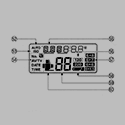|
I have some Cat5e in my walls that was used for telephone back in the day. Using a cable tester I can verify that one wire at the termination point is wired correctly for ethernet but it seems to be spliced in the wall at some point because I get continuity on two outlets in my house. When I try to connect it to my network it's not working, I'm assuming because of the splicing. Is there anything I can do or is it a lost cause.
|
|
|
|

|
| # ? Jun 6, 2024 11:57 |
|
Pull new cat6a, it's not worth it to mess with sketchy cables.
|
|
|
|
If I ever build or reno a house I’m putting really swank conduits in for all my cabling needs with nice curvatures for fibre etc It’s one of those “if I won the lotto” nerd dreams.
|
|
|
|
EngineerJoe posted:I have some Cat5e in my walls that was used for telephone back in the day. Using a cable tester I can verify that one wire at the termination point is wired correctly for ethernet but it seems to be spliced in the wall at some point because I get continuity on two outlets in my house. When I try to connect it to my network it's not working, I'm assuming because of the splicing. Is there anything I can do or is it a lost cause. It's not uncommon for people to have used Cat5e for telephone instead of running old school telephone twisted pairs. If it was spliced, that means they were pulling out twisted pairs to use for different ports. Rip it out and replace it. For anyone else in a situation where you need phone but only have Cat5e, you can use a Cat5e cable with an RJ45 jack as an old school analog phone port. It clips in just like an old school phone port, snaps to the middle, and only uses the middle twisted pair. It's backwards compatible. Internet Explorer fucked around with this message at 17:33 on Sep 7, 2022 |
|
|
|
EngineerJoe posted:I have some Cat5e in my walls that was used for telephone back in the day. Using a cable tester I can verify that one wire at the termination point is wired correctly for ethernet but it seems to be spliced in the wall at some point because I get continuity on two outlets in my house. When I try to connect it to my network it's not working, I'm assuming because of the splicing. Is there anything I can do or is it a lost cause. Look for a phone distribution block somewhere, where the cat 5e runs are all punched down. In one of my previous houses, I ripped out the distribution block, terminated the runs into a small Ethernet patch panel, and put a switch there. Bam, instant gigabit network.
|
|
|
|
smax posted:Look for a phone distribution block somewhere, where the cat 5e runs are all punched down. I'll take a look, there are 4 lines total in the basement and one goes only to our bedroom and that's working fine for gigabit. The others are clearly connected together somehow. If it is in a central area maybe I can actually find it and undo the splicing.
|
|
|
|
EngineerJoe posted:I'll take a look, there are 4 lines total in the basement and one goes only to our bedroom and that's working fine for gigabit. The others are clearly connected together somehow. If it is in a central area maybe I can actually find it and undo the splicing. Going to reiterate the recommendation of pulling the new cable; if the old stuff isn't tacked to the studs or whatever, use it as a pull through to snake the new cable. It's generally not that expensive at the moment and you'll be thankful for less janky network issues because of cables spliced together. Hell, I have about 300ft of Cat6e on a spool that you can have for the cost of shipping if you want it.
|
|
|
|
Honestly, I don't really need an outlet here, wifi works fine for my purposes and I have Powerline ethernet to this room for the printer and smarthome things. I'm just tinkering to see if I can do it. I already ran Cat6A to my desktop PC and home theatre. I'm almost at the point of giving up since, but it was a fun little puzzle.
|
|
|
|
I installed pfsense on I3 6300T, 8GB ram, 256GB SSD. Now I look at basically no usage of the hardware outside of when downloading with my 1Gbps connection using VPN. Anyways, would it make sense to install ESXi instead, and since pfsense seems to be a bit of legacy software these days, install opnsense instead to a VM? Then I could run another VM with stuff, since the pfsense does not seem to tax the machine. Ram usage is 6% so like 500MB  CPU usage while downloading is under 20% with OpenVPN. Wireguard would probably be even more efficient. CPU usage while downloading is under 20% with OpenVPN. Wireguard would probably be even more efficient.Are there any real risks when using a router/firewall inside a VM?
|
|
|
|
Ihmemies posted:I installed pfsense on I3 6300T, 8GB ram, 256GB SSD. Now I look at basically no usage of the hardware outside of when downloading with my 1Gbps connection using VPN. I used to virtualize pf on ESXi. It works perfectly, especially if you pass through a network card.
|
|
|
|
Alternatively start throwing packages on it like Snort, Pfblockerng, and watch the RAM usage crest 50%.
|
|
|
|
EngineerJoe posted:I'll take a look, there are 4 lines total in the basement and one goes only to our bedroom and that's working fine for gigabit. The others are clearly connected together somehow. If it is in a central area maybe I can actually find it and undo the splicing. As a starting point, look for where your phone line comes into the house. The distribution block could be jut about anywhere, I've seen them outside, in attics, basements, utility/network closets, etc. Seeing where it goes in should at least point you in a direction.
|
|
|
|
future ghost posted:Alternatively start throwing packages on it like Snort, Pfblockerng, and watch the RAM usage crest 50%. Maybe I will try this instead. I have a spare 8700K+mobo I could use to run a server. Just need a case, maybe define R5 used, and some RAM.
|
|
|
|
Anyone who has been looking to upgrade to Wi-Fi 6 and doesn't need mesh or central management might want to know that the Netgear WAX202 is $30 on Amazon again. This has 2x2 radios for both 2.4GHz and 5GHz bands with three 1G LAN ports. I bought one of these to try out for my parents since they recently got an upgrade to fiber and tested it with a few devices on my own 1G fiber connection. I typically saw 500-750Mbps on Speedtest with a couple laptops using the Intel AX200 and 300-450 with my Wi-Fi 5 phone, using an 80MHz channel in the 5GHz band from 2-4 feet away. This is of course pretty close to an ideal scenario, but it still seemed like pretty solid numbers for the price. It's also possible to install a pre-release version of OpenWRT which seemed to work perfectly except that Wi-Fi speeds were about 30% lower. I hope that will be fixed in the future if it becomes officially supported, since with 128MB flash/512MB RAM this should be a pretty capable machine. e: This model appears to be officially supported in OpenWRT 22.03, released on September 6th. Eletriarnation fucked around with this message at 22:41 on Sep 10, 2022 |
|
|
|
Hi Networking Goons, I was hoping to get some help/recommendations. When we moved into our ~ 2100 sq. ft. house about 3 years ago, I bought the Google Wifi 3-puck mesh network router/extenders to spread them out around the house and provide good coverage. Overall they worked well for most of this time, but just recently, we're starting to see really slow speeds on wireless devices, i.e. we have 500 Mbps fiber, and on wired systems, we can easily hit 350-400+ Mbps download/upload, but on wireless, it sometimes gets down to 15-20 Mbps. We also then sometimes see dropped connections, etc., such as streaming services stopping and such. Trying to trouble shoot this, I haven't really had a whole lot of luck. The system is on the current firmware, and the Google Home app isn't reporting any issues... I've tried restarting the network, power cycling it, etc., and when it's having issues, none of this seems to have any effect. There are some times of the day where the speed does go up to 50-60 Mbps though on some wireless devices. Is this probably interference somewhere? I'm honestly to the point where I'm almost ready to replace it all, and so if I do, I did have a few questions: 1. The house is 2100 sq. ft., but wood frame, and the overall parcel is about 8,000 sq. ft. Do I really even need a mesh network? 2. We're a four, soon to be five, person household that has a mix of usually a few laptops, a few streaming devices, etc., running. What would be ideal for this router-wise? 3. Long-term I do want to run Cat6 to each room, but that's down the road... Thank you!
|
|
|
|
As far as the interference question goes, I'd recommend using a utility like Ubiquiti's WiFiman to try mapping out where you do and don't get a good signal on the channels you're using and any other channels which may be conflicting. You can then potentially try moving your existing equipment, changing channels, etc. to improve the situation. I don't have any experience with mesh systems directly but from your description of speed topping out at 50-60Mbps, you're probably connected either over 2.4Ghz or a very weak/noisy 5GHz signal. Even if you're in line of sight of one of the extenders, if it doesn't have a good signal to the router then the problem will be the same. 1) This is a question of layout as well as size. Studs and drywall aren't nearly as bad as masonry, but you still will lose some signal with each wall between you and the base station. I have a 1300 sq. ft. house and only use one ceiling-mounted AP, but it's a layout with a central hallway where I can get line of sight to half of the house. I would say generally for good performance you don't want your client more than one room away from whatever router/extender/AP it's talking to. I would expect to be able to get some useful signal to all of a 2100 sq. ft. house with one AP, but with a lot of layouts I'd want 2-3. 2) It sounds like a pretty typical mix of devices. If they're frequently all streaming in the same area so that they'd be connecting to the same base station, having that be the router and not one of the extenders would probably make a big difference. If you can get a 4x4 5GHz radio for MU-MIMO and be in line of sight, then that's ideal. If they aren't connecting to the same base station, at least having some of them on the router is good because otherwise your extenders are going to have to share the router's airtime. 3) I highly recommend getting a wall box that mounts in between studs, sticking it in a closet or wherever else is a good spot for your wired devices, and running cable from a PoE switch/injector there to ceiling mounted APs. The wire runs are easy once you get them into the attic, and you'll be hard pressed to find a more effective or convenient place to stick a regular router.
|
|
|
|
Is Ubiquiti restocking their AC stuff? I want to get a UAP-AC-M to mount on my pole barn to get the Wi-Fi signal out to my fire pit area, but it hadn’t been in stock for months. Third party stores have them for $160, at that point I might as well just buy the Wi-Fi6 version.
|
|
|
|
What kind of router should I get if i wanted IP-based bandwidth monitoring/throttling? Maybe get one of those fancy Ubiquiti ones? https://store.ui.com/collections/unifi-network-unifi-os-consoles/products/udm-us
|
|
|
|
Through work I got to speak with a wifi company internal staff and the answer is no one is making wifi5 devices due to supply issues in manufacturing in covid times. Generally wifi5 ap required multiple chips to be made, while wifi6 is a single chip effectively. So therefore with limited chip production capacity, wifi6 is the preferred item. Also, it has the advantages of requiring client companies to upgrade their gear, so that made sales people happy too. Basically you're forced to go wifi6.
|
|
|
|
We've already seen that Ubiquiti will cut off products entirely when they get old enough, so I would not pay new prices for last generation gear. Even if you don't care about the performance difference (which is admittedly not huge for single clients using the same channel width), at some point you will probably care about the model hitting end of support and forcing you to replace it or switch to OpenWRT.
Eletriarnation fucked around with this message at 22:51 on Sep 10, 2022 |
|
|
|
Never ye mind also the recent Intel-Broadcom Wifi 7 demo. With that on the way, the clock is ticking on 6/6E, so you might as well. Swear to god, if Ubiquiti ships Wifi 7 devices without 2.5GbE minimum, that should be the impetus for a new OP. loving Engenius and Ruckus already do it, why can't they? SwissArmyDruid fucked around with this message at 23:18 on Sep 10, 2022 |
|
|
|
Counterpoint: If you have devices that benefit from anything more than 1000BaseT, you'll probably benefit more from doing 10GBaseSR using OM3 as it has lower latency, uses less power, and is not going to be impacted by other people setting up their own BSSIDs and loving with your airtime. If I understand things right, Wifi 6+ (and LTE(A), and most other modern standards) have time division which is made to work in environments where different beacons/cells can talk together over the wired connection to negotiate airtime - to ensure maximum coverage based on how many clients each device handle while minimizing the hidden node problem. If you've got a lot of neighbours with a similar technology but your networks aren't connected together, you don't benefit from this and with enough neighbours, there'll be no airtime.
|
|
|
|
|
EngineerJoe posted:I have some Cat5e in my walls that was used for telephone back in the day. Using a cable tester I can verify that one wire at the termination point is wired correctly for ethernet but it seems to be spliced in the wall at some point because I get continuity on two outlets in my house. When I try to connect it to my network it's not working, I'm assuming because of the splicing. Is there anything I can do or is it a lost cause. The blue pair would have been used for phone - follow it back to wherever that phone wiring is terminated in the house and rewire it there. I can’t see anyone bothering to splice the wire, but someone sufficiently lazy could run a pair between outlets in the same immediate area to skip a second home run
|
|
|
|
GreenBuckanneer posted:What kind of router should I get if i wanted IP-based bandwidth monitoring/throttling? Maybe get one of those fancy Ubiquiti ones? Mikrotik will do it. I use PCQs for this. There’s some steps to essentially tell the thing which IP addresses you want to tag with a particular label, then what queue applies to that label. I set it up for 15Mbit per client, but had a priority list for others who should get up to 50. I nested that in one that’s ~5Mbit less than the total connection size. It essentially divides the available bandwidth up if needed to make sure no one client could kneecap everyone else. There are some YouTube videos which show how to do this, so you can decide if it’s something you want to play with. https://youtu.be/RK-1mRgTEPg this gives at least an overview. I’m positive there are some consumer ones that do similar without the complexity, but if you are going to jump towards ubnt perhaps you’re looking for more.
|
|
|
|
Something weird happened on my network yesterday. I got a switch from ebay, Dell Powerconnect 5524P (24 gigabit ports, POE, 2 10G SFP+) to replace my existing 16 port unmanaged tp-link switch. I installed it, factory restored it (just from the reset button, i don't have a serial cable just yet), and started to move my connections over. The switch is in the basement, and I have cables pulled to every room where there are other switches that give connectivity to whatever devices are in that room. I didn't want to cut connectivity to everyone else in the house so I just moved to the new switch my office and bridged the 2 switches with a new cable. All seemed to be working fine for a couple of minutes, after which all hell broke loose. 90%+ packet loss throughout the network. Like ... a poison. After many hours of troubleshooting and an angry family, I figured out that if I move all connections to the new switch and disconnect the old switch, everything is fine. Somehow, the old switch being in the network is causing mayhem. Is that ... possible? Or is there likely another issue here that I should be looking at? For the moment I don't need the old switch, but I had plans to put it in service in another room. Could be the POE from the new switch to mess with old one? I don't know what got over me to buy a poe switch, I thought that it'd be neat if/when I want to power some wifi APs or some such. Never expected these kinds of issues.
|
|
|
|
Shout out to devmd01 for pointing me to this thread. For a house built in 2014 there are some odd decisions that were obviously made in this place. Like the huge number of RF sockets, and the huge number of telephone sockets but no ethernet. Also neither the RF sockets nor the phone sockets work. I had my memory jogged about phone lines being wired with cat 5 and in a flash of inspiration I removed the cover from what I *thought* was a cover for some electrical cables (but actually had the inbound line for broadband) and found this:  Well now we know why the RF sockets don't work  There are four cat 5e lines in there:  I'm *guessing* that there's one going to each floor (except there aren't four floors) and then these are run in a ring? I took a random phone socket off and it's configured like this:  Which, idk, maybe looks like that? I was figuring I could check continuity from those 4 cables to the "first" socket on each floor and convert that to ethernet if it's where I want it, or get a double socket on there and loop it back with a patch cable to get a connection in the room I actually want it to be in. Or should I just buy a WiFi mesh network and save myself a lot of hassle? Edit: yeah ok that's an extension socket so there should be a master somewhere else in this room and that probably links to one of those 4 wires in the box, so I should be able to replace that with an ethernet point. or actually connect these up should I desire a landline for some weird reason. edit 2: Nope, after checking the sockets there's actually not as many sockets as I thought, and actually just one room that has extension sockets (and the master is behind a false wall put in by the previous owner which is its own horrorshow because there are sockets behind it they just took the faceplates off and left chilling out). Other floors have one room with a master socket and zero extensions. In true style, the room I wanted the ethernet port in doesn't have a socket to convert 
Powerful Two-Hander fucked around with this message at 17:51 on Sep 11, 2022 |
|
|
|
Volguus posted:Something weird happened on my network yesterday. I got a switch from ebay, Dell Powerconnect 5524P (24 gigabit ports, POE, 2 10G SFP+) to replace my existing 16 port unmanaged tp-link switch. I installed it, factory restored it (just from the reset button, i don't have a serial cable just yet), and started to move my connections over. Is there an accidental loop somewhere? Sounds like a broadcast storm possibly. The Dell is smart enough to have STP or RSTP, your unmanaged one, highly unlikely.
|
|
|
|
movax posted:Is there an accidental loop somewhere? Sounds like a broadcast storm possibly. The Dell is smart enough to have STP or RSTP, your unmanaged one, highly unlikely. Hmm, how can I find out? My network is laid out in a star pattern, with the basement switch (now dell) being the central switch, and connected to it is the gateway, all the rooms and all the other computers that I have in the basement. In every room there's another smaller switch for the devices in there. Maybe in the basement, as things grew, they have gotten out of control? I have in there: 1 gateway 1 2U server, full of VMs 1 PiKVM rpi, 1 RPI that has pihole 2 computers from work Googling about loops it seems that there are people/companies who are selling tools to detect them. So it's clearly a thing that happens. edit: watching some more videos that's what maybe I actually did. by connecting the 2 switches I most likely created a loop. God drat, networking is hard. Volguus fucked around with this message at 20:32 on Sep 11, 2022 |
|
|
|
You'd detect a broadcast storm immediately if you run a Wireshark capture on a port that's connected to the switch, because you'll see the broadcasts coming in on the host too. It shouldn't happen with a star topology though - you do need some kind of path that actually loops back on itself, and usually that's going to be two switches connected together on two different ports unless the managed side of what you're doing has a very strange configuration which is bouncing traffic out the same port it came in on. Switches are generally smart enough not to do that on their own, even unmanaged ones. It could also be a host like a PC which is connected to both switches and has the two ports bridged together. Eletriarnation fucked around with this message at 20:33 on Sep 11, 2022 |
|
|
|
I have a 'dumb' IOT device I want to connect at work but the work wifi requires a webpage login to activate which my IOT devices can't access. I have a personal Win11 desktop at work that's on the work wifi. Can I create my own 'hotspot' from this machine? Do I need 2 wifi adapters? Will this make my machine's main outbound wifi slower? As for security I'm not really worried. The work wifi which my personal machine is on is for personal devices like phones and appleTVs, etc. and is in its own sandbox that is isolated from the production network.
|
|
|
|
Eletriarnation posted:You'd detect a broadcast storm immediately if you run a Wireshark capture on a port that's connected to the switch, because you'll see the broadcasts coming in on the host too. I just tried to do that. Have an old laptop and took it in the basement, connected it directly to the switch, and powered it on. Can't get IP address!!! Move the laptop to another room, plug it into the network port (which is, via 1 cable and 1 patch panel connected to the same switch) and now it gets IP just fine. WTF? Connected it to the switch directly again, no IP. Started wireshark on the laptop to see what's happening. I can see ARP packets, I can see the switch itself broadcasting STP packets, I can see when my laptop makes the DHCP request, but gets no response. I looked in the logs of dnsmasq on my gateway and there's no DHCP request coming at that moment. If I turn on wifi on the laptop, the DHCP request shows up just fine in the log. Wifi gets IP. I'm completely flabbergasted on how could I gently caress this up so much. Definitely something's really wrong, even though the network right now is working ....
|
|
|
|
If ‘the switch’ is this dell I would think that it is perhaps not actually factory defaulted . Usually on an enterprise switch you cannot just press a button to reset the device . As to the loop, who knows, I wouldn’t spend time on it , especially without console on the switch to inspect what is happening .
|
|
|
|
Partycat posted:If ‘the switch’ is this dell I would think that it is perhaps not actually factory defaulted . Usually on an enterprise switch you cannot just press a button to reset the device . Maybe you're right, I found out on the internet somewhere that pressing the reset button for 10 seconds factory resets it, but most other sources only mentioned via the console. Got today an USB to RS-232 cable from amazon, gonna to log into it after everyone goes to sleep.
|
|
|
|
luckily i grew up with this sort of thing in IT kindergarten and early elementary school The switch is a dell The switch is a dell Hi-ho, the derry-o The switch is a dell The switch takes an arp The switch takes an arp Hi-ho, the derry-o The switch takes an arp The arp broadcast's it's need The arp broadcast's it's need Hi-ho, the derry-o The arp broadcast's it's need The need exits both ports The need exits both ports Hi-ho, the derry-o The need exits both ports The ports announce all traffic The ports announce all traffic Hi-ho, the derry-o The ports announce all traffic The traffic congests the paths The traffic congests the paths Hi-ho, the derry-o The traffic congests the paths ok i think that's enough
|
|
|
|
I've just wired my house with cat6, and I'd like to do an inexpensive backhaul mesh, AND access the router via web interface (like an adult) to forward ports and such. There are several 2-3 piece mesh kits available for under $300, but reviews indicate that they require mobile apps to administer, and the administration options are extremely limited. The following Synology pair seem to tick my desired boxes: - Browser admin - Ability to forward ports, set static IPs - Under $300 total Synology RT2600ac https://www.amazon.com/gp/product/B01N5MPTG1/ref=ewc_pr_img_3?smid=ATVPDKIKX0DER&th=1 Synology MR2200ac https://www.amazon.com/gp/product/B07HPSQZKN Is this an ok choice?
|
|
|
|
Captain Pike posted:The following Synology pair seem to tick my desired boxes: They're WiFi 5 (802.11ac) devices, not WiFi 6.
|
|
|
|
802.11ac ought to be enough for anybody
|
|
|
|
isn't it 1.3gbps? my actual internet is 100mbps so the only thing that we're talking about for wifi would be something that needs the bandwidth locally, and even if we assume an endpoint wants to transfer something like a 4k? plex rip that's what, 50mB/s or 400 megabit, plenty of room unless you have 3+ people doing that all at the same time
|
|
|
|
Bits or bytes per second, orders of magnitude thereof, don't matter when there's no airtime. Video generally is measured in bits per second, not bytes - and that's true for any bandwidth measurement.
|
|
|
|
|

|
| # ? Jun 6, 2024 11:57 |
|
Captain Pike posted:I've just wired my house with cat6, and I'd like to do an inexpensive backhaul mesh, AND access the router via web interface (like an adult) to forward ports and such. I'm confused by your decision to look for a mesh when you said you have wired the house. Do you just mean that you want base stations which are designed to work in a group, or that you're actually planning to use wireless uplinks on some of them? I generally think of the term 'mesh' as implying the second. If you are planning to have wired uplinks for every unit then you don't need to order some special mesh kit, you just need to make sure that the different base stations connect back to the same LAN and use the same SSID/security settings. Clients are generally happy to roam if you give them that much. There are certainly much more expensive units out there but for the requirements you've listed, I think you could get any two recent units that support OpenWRT and put that on them and spend a lot less than $300.
|
|
|


















































